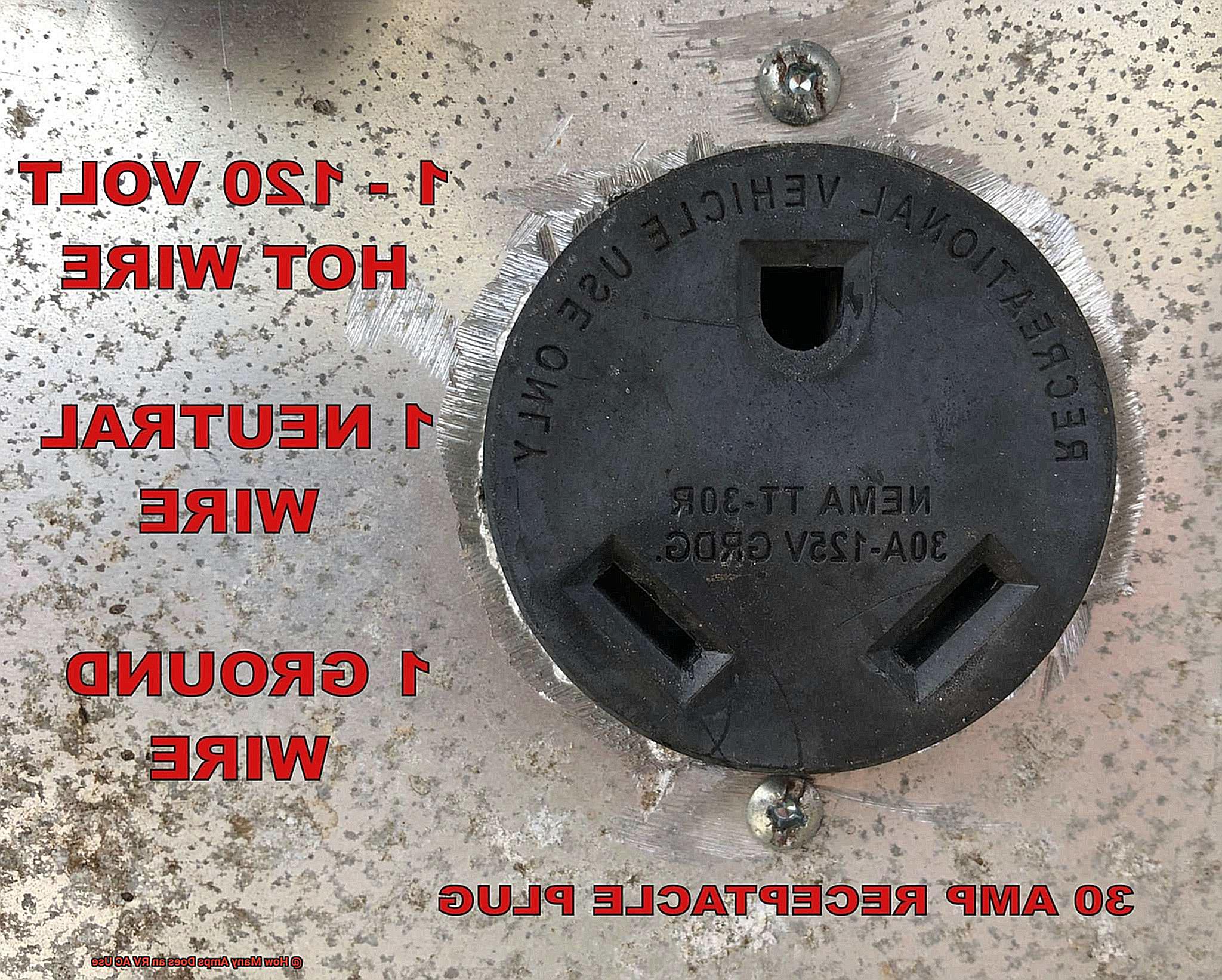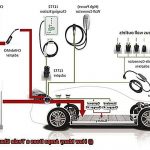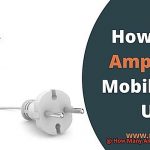Are you gearing up for an epic RV road trip this summer? Before you hit the open road, it’s important to know how much power your RV air conditioner uses. After all, the last thing you want is to be stuck in sweltering heat with a tripped circuit breaker or a damaged electrical system.
On average, an RV air conditioner draws between 12 and 18 amps of electricity, depending on the model and size of your vehicle. To put that into perspective, it’s like running two to three standard refrigerators simultaneously. That’s a lot of juice.
But don’t panic just yet. The type of electrical hookup available at your campsite or RV park can make all the difference. If you’re plugged into a 30-amp service, you’ll have a maximum of 3,600 watts to work with. On the other hand, if you’re connected to a 50-amp service, you’ll have up to 12,000 watts at your disposal.
In this blog post, we’ll delve into everything you need to know about RV air conditioner power consumption. From factors that affect energy usage to tips for conserving power and staying cool during your adventures on the road – we’ve got you covered. So sit back, relax and read on to learn more about how many amps an RV AC uses.
What Factors Determine the Number of Amps an RV AC Uses?
Contents
- 1 What Factors Determine the Number of Amps an RV AC Uses?
- 2 Average Amps Used by an RV Air Conditioner
- 3 The Starting Power Requirements of an RV AC Unit
- 4 Generators and Solar Panels for Off-Grid Camping
- 5 Checking Specifications Before Operating Your RV AC Unit
- 6 Ensuring Sufficient Power Sources for Your RV AC System
- 7 Conclusion
Here are some key factors to consider:
The size of your AC unit is one of the most significant factors that impact its power consumption. Larger units have more cooling power and typically use more amps than smaller ones. However, keep in mind that a larger unit may be necessary if you have a larger RV or plan on camping in hotter climates.
Efficiency is another factor to consider when selecting an AC unit. More efficient units will consume fewer amps than less efficient ones. Look for a high SEER (Seasonal Energy Efficiency Ratio) rating, as this will indicate that the unit is designed to consume less energy while still providing adequate cooling.
The temperature outside will also impact how many amps your RV AC uses. The hotter it is, the harder your AC unit will have to work to keep your RV cool, which means it will consume more amps. If you plan on camping during the summer months or in hot climates, make sure your AC unit can handle the extra workload.
The insulation of your RV is another critical factor. If your RV is poorly insulated, your AC unit will have to work harder to cool the interior, which means it will consume more power. On the other hand, a well-insulated RV will help reduce its amp usage and save energy.
Starting an RV air conditioner requires more power than running it continuously. This is because the compressor needs an extra surge of electricity to start up. Ensure you have a sufficient power source when starting up your RV AC unit, whether it’s a generator or solar panel system.
Investing in a generator or solar panel system can be an excellent way to power your RV AC when camping off-grid. However, make sure it can handle the electrical load required by your AC unit.
In conclusion, understanding the factors that determine the number of amps your RV AC uses is vital for a comfortable and safe camping experience. Check the specifications of your AC unit, insulation of your RV, and ensure you have a sufficient power source before operating it. With this knowledge, you can enjoy a cool and comfortable camping experience without any electrical issues.
Average Amps Used by an RV Air Conditioner
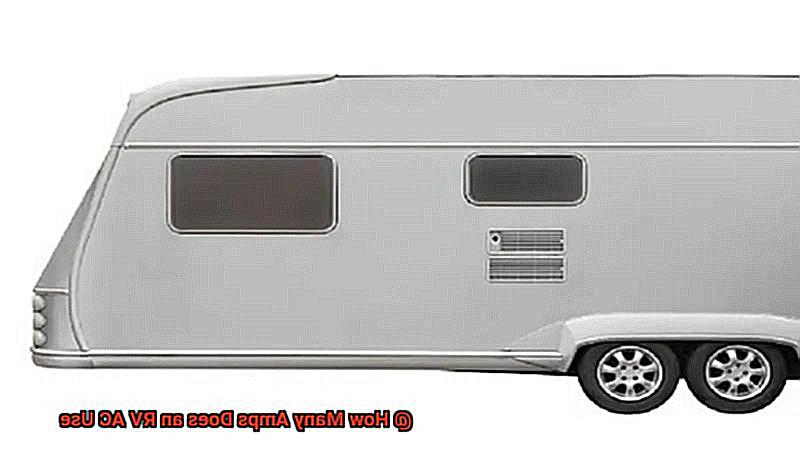
Understanding the average amps used by an RV air conditioner is crucial to ensure that your electrical system can handle its energy demands.
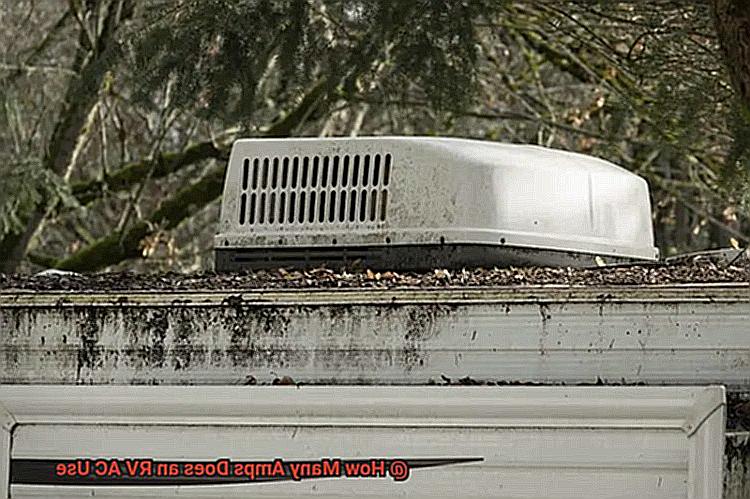
On average, RV air conditioners consume between 12-16 amps when running. However, this is just an estimate, and several factors can impact its energy usage. For instance, larger air conditioning units will typically use more amps than smaller ones. Similarly, older RV models may not have a large enough electrical system to support modern air conditioning systems.
To avoid overloading your electrical system and enjoy a comfortable living space, it’s essential to know precisely how many amps your RV air conditioner uses. You can use a device called an ammeter to measure the amount of electrical current flowing through a circuit and get an accurate reading of the amps consumed by your air conditioner.
If you’re camping off-grid and need to power your air conditioner, investing in a generator or solar panel system can be an excellent option. However, keep in mind that these systems also have specific energy limits and may not be able to handle the demands of larger air conditioning units.
In conclusion, understanding the average amps used by an RV air conditioner and the factors that impact its energy usage is crucial for planning and enjoying a comfortable and cool living space while on the road. Remember to do your research and invest in the right tools to make your adventure a success.
The Starting Power Requirements of an RV AC Unit
Well, let’s talk about the starting power requirements of your RV AC unit. You see, this crucial factor determines the amount of electricity required to turn on your AC unit.
RV air conditioning units need more power to start than they need to run continuously. This is because the compressor within the AC unit requires a high amount of electricity to kick-start the cooling process. Typically, the starting power requirement of an RV AC unit is measured in amps and can vary depending on the size and type of the unit. On average, a typical RV air conditioning unit has a starting amperage of around 15-20 amps. However, larger units can require up to 30 amps or more.
Understanding your AC unit’s starting power requirements is critical as it ensures proper operation and prevents potential damage to both the electrical system and the AC unit itself. If your RV’s electrical system cannot provide enough power to start your AC unit, it could cause severe problems during your trip.
To avoid this nightmare scenario, it’s essential to use a generator that provides enough wattage to handle the starting power requirements of your AC unit. Besides, it’s crucial to manage your electrical usage by turning off unnecessary devices when running your AC unit. Simultaneously turning on other high-power electrical devices can overload your RV’s electrical system.
In conclusion, knowing the starting power requirements of your RV’s air conditioning unit is crucial for ensuring its proper operation and preventing potential damages. By following these guidelines, you can ensure that your RV’s air conditioning system remains functional and reliable during your travels.
Generators and Solar Panels for Off-Grid Camping
No worries, my friend. As an expert in generators and solar panels for off-grid camping, I’m here to guide you through the differences between these two power sources.
Generators are a reliable and convenient option, providing higher wattage output to handle the starting surge amps required by your RV air conditioner. They come in different sizes and capacities, with most RV generators ranging from 2,000 to 4,000 watts. However, generators require fuel and produce noise and emissions, which might not be ideal for those seeking a more eco-friendly experience.
On the other hand, solar panels are an eco-friendly and cost-effective option for off-grid camping. They use sunlight to generate electricity and can be paired with a solar charge controller and battery bank to store excess energy for later use. However, it’s important to calculate your power needs before deciding on a solar setup since they have lower wattage output compared to generators.
To determine how many amps your RV air conditioner uses with a generator or solar panel setup, you need to know the wattage of the air conditioner and the starting surge amps required to turn it on. Typically, an RV air conditioner will require between 1,200 and 1,500 watts to run and up to 3,500 watts of starting surge amps.
If you’re opting for a generator, you need one that can handle at least 3,500 watts of surge power to start your air conditioner without tripping the breaker. On the other hand, if you’re using solar panels, you’ll need to divide the rated watts of your air conditioner by the voltage of your battery system (usually 12V or 24V) and multiply by 1.25 (for losses due to inefficiencies). For example, if your air conditioner is rated at 1,500 watts and you have a 12V battery system, you will need at least six 250-watt solar panels to provide enough power.
Ultimately, the choice between generators and solar panels for powering your RV air conditioner while camping off-grid depends on your power needs, budget, and personal preferences. Generators provide higher wattage output but require fuel and produce noise and emissions, while solar panels are eco-friendly and cost-effective but have lower wattage output and require sunlight to generate power.
Checking Specifications Before Operating Your RV AC Unit
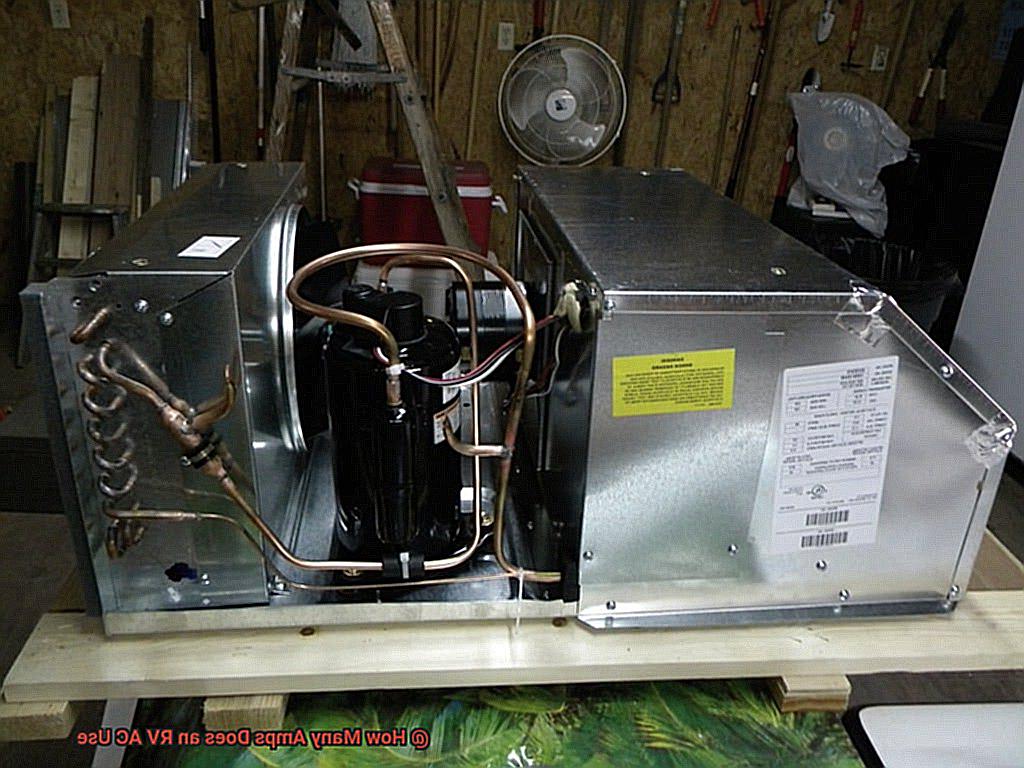
It may not be the most thrilling task on your camping to-do list, but it could save you from major electrical issues in the future.
Think of your RV’s electrical system like a set of puzzle pieces: they’re meant to fit together perfectly. Overloading your electrical system with too many amps is like trying to cram a square peg into a round hole. It just won’t work and could potentially put you in danger.
To avoid overloading your electrical system, it’s crucial to understand how many amps your RV AC unit uses. You can find this information in your owner’s manual or by using a clamp meter, which measures the current flowing through a wire or cable and gives you an accurate reading of the amps being used.
But don’t stop there. You should also consider the power source you’re using for your RV AC unit. If you’re connected to a 30-amp service, for example, be mindful of how many other electrical devices or appliances are running at the same time as your AC unit. Balance is key.
By taking the time to check the specifications and power requirements of your RV AC unit, you’ll operate it safely and efficiently. This will help prolong its lifespan and prevent any potential electrical issues in your beloved RV.
Before hitting the road, make sure you’re giving your RV AC unit the power it needs without overwhelming your electrical system.
Ensuring Sufficient Power Sources for Your RV AC System
One of the most crucial pieces of this puzzle is understanding how many amps your RV AC unit uses and ensuring that you have sufficient power sources to run it efficiently.
When it comes to ensuring sufficient power sources for your RV AC system, it’s crucial to understand how many amps your AC unit uses. This information will help you determine how much power you need to run your AC unit and whether your RV’s electrical system can handle the load. The average RV AC unit uses between 12 to 16 amps when running, but this number can vary depending on the size and type of AC unit you have.
However, knowing the number of amps your RV AC unit uses is only one part of the equation. You also need to consider other factors such as the size and capacity of your RV’s batteries, the type of converter or inverter you have, and the amount of power available at your RV park or campground.
To ensure that you have enough power to run your RV AC unit efficiently, it’s recommended that you have at least a 30-amp electrical service. This will provide enough power to run your AC unit as well as other appliances and electronics in your RV without overloading your electrical system. Imagine having a comfortable living space while on the road without any worries about overloading your electrical system.
If you plan on using your RV AC unit frequently, investing in additional power sources such as solar panels or a generator may be worth considering. These can help supplement your RV’s electrical system and provide additional power when needed. With these additional power sources, you’ll never have to worry about running out of power while on the road.
Knowing how many amps your RV AC unit uses is essential for ensuring that you have sufficient power sources and can enjoy a comfortable living space while on the road. By taking the time to assess your electrical needs and investing in additional power sources if necessary, you can ensure that your RV AC system runs smoothly and efficiently.
Z8IvMWqVY-M” >
Conclusion
In conclusion, understanding the power requirements of your RV AC is essential for a comfortable and safe camping experience. On average, an RV air conditioner draws between 12 to 18 amps of electricity, depending on the size and model of your vehicle. However, several factors can affect its energy usage, such as the efficiency and insulation of your RV or the temperature outside.
To prevent any damage to both your electrical system and AC unit, it’s crucial to know the starting power requirements of your RV AC. If you’re planning to camp off-grid and need to power your air conditioner, investing in a generator or solar panel system can be an excellent option.
Before hitting the road this summer, ensure that you have sufficient power sources to run your RV AC efficiently without overloading your electrical system. Checking the specifications of your RV AC unit can help prolong its lifespan and prevent potential electrical issues in your beloved RV.
By following these guidelines, you can enjoy a cool and comfortable camping experience without any electrical problems. So go ahead and make sure you know how much power your RV air conditioner uses, invest in additional power sources if necessary, and take steps to operate it safely and efficiently.
